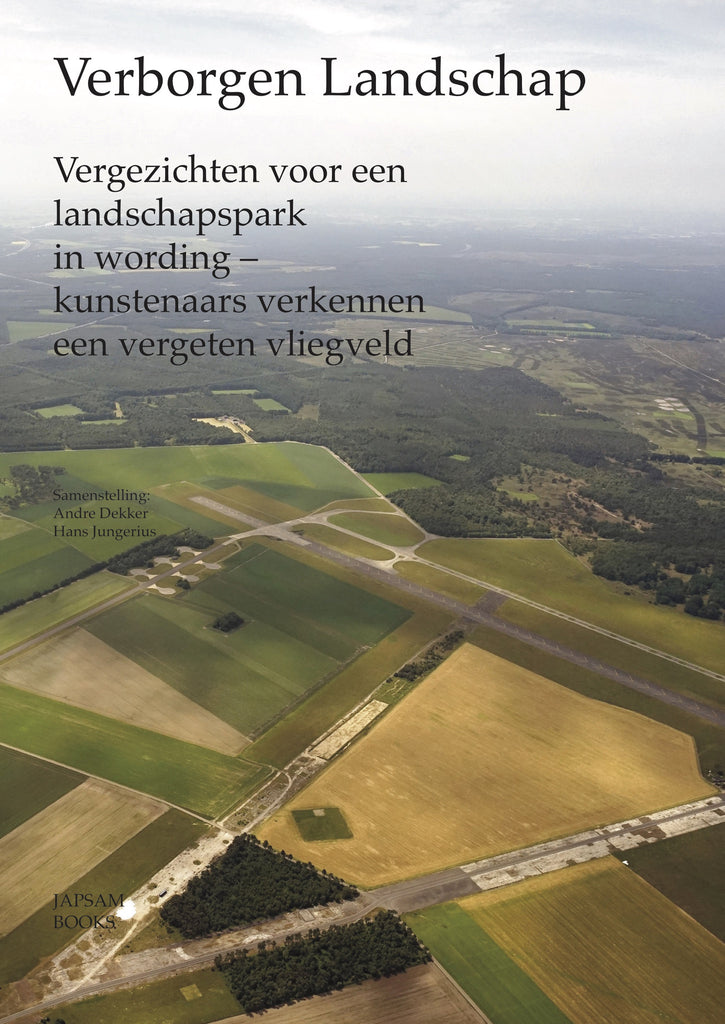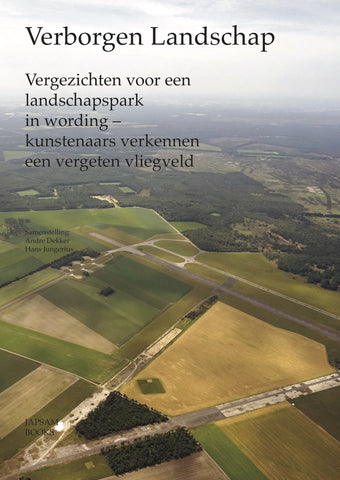Your cart is currently empty!
Verborgen Landschap
+++Vergezichten voor een landschapspark in wording - kunstenaars verkennen een vergeten landschap +++
+++Andre Dekker, Caro Delsing, Hans Jungerius, Jaap Kroneman (eds.)+++
978-94-90322-83-0
Jaap Kroneman
200
17 x 24 cm
Softcover
Dutch with short English summary
Release date: April 2017
Co-publisher: Stichting Verborgen Landschap, www.verborgenlandschap.nl
This publication was made possible with the support of Gemeente Arnhem, Provincie Gelderland, Prins Bernhard Cultuurfonds Gelderland and Stichting Stokroos.
Verborgen Landschap (Hidden landscape) describes the paradox of isolated, yet publicly accessible forests, fields and grand forest lanes. It indicates the anomaly of a twilight zone between international brands as Sonsbeek, Van Gogh, Burgers’ Zoo and Open Air Museum. This latent landscape park is located prominently halfway between Randstad, the conurbation of four big cities of Holland and the Ruhr Valley metropolis. On a local level it sits between Sonsbeek Park, well-known for it’s public art quadriënnale and Kröller-Müller Museum, famous for it’s setting in the National Park and collection of Van Gogh. You imagine you are in a remote unexplored area, but this area is just silent because there are no through-roads. Although the width of this area is not much more than a half hour’s walk, and the length around two hours, the visitor can only discover the many national monuments and the great scenic and environmental value with the help of a guide.
How is it that this particular area is accessible, but not connected? What is the history of this area enclosed by internationally known and popular woods, moorland, national parks and attractions? Why is it that the obvious significant cultural and historical value has not been recognized or investigated?
This book reveals the history of forests and fields full of fascinating stories big and small. It presents a collection of unique historical maps, artistic drawings, artistic-documentary photographs and intriguing studies by 24 explorers from the fields of landscape architecture, art and design. This work is for professionals, students and lovers of landscape sciences, visual arts, tourism and cultural heritage. The book is also of value to planners and policy makers.
Perception of landscape is central to this atlas. A landscape is by nature what we see and experience, combined with our own unique social and cultural knowledge of places. But how we want to see it and what we imagine it to be defines the use of the word. This is an atlas of landscapes of the mind - an account of a series of profound and imaginative studies in the field: Dream landscapes, reflections, visions and speculations by internationally renowned designers whose careers are closely connected to landscape and outdoor space. It is an account of a series of profound and imaginative studies in the field. Through these surveys a new type of landscape can be created where existing forests, fields and lanes take shape by processing and staging by artists, which is of a different order than the usual artistic upholstery modeling of sculpture parks, country parks and estates.
An inspiration for spatial planning, this book provides insight into a research methodology in which a period of isolation leads to imagination and vision to inspire planning, cultural history and the arts. Policymakers can draw from an arsenal of leitmotifs, cultural values and prospects before they are led by political-ideological motives and conflicting interests.
Since 2013, Stichting Verborgen Landschap (Hidden Landscape Foundation) has invited artists, researchers and landscape architects to do reconnaissance from the heart of Buitenplaats Koningsweg in Arnhem, a former military site which has been transformed to a cultural enclave. The majority of the explorers are independent artists or researchers specializing in landscape who strive for a land-use, which appeals to the imagination. Their findings form the core of this book. Scholarships enabled them to work in the relative seclusion of the woods and fields around Schaarsbergen, north of Arnhem, guided by their curiosity, their professional expertise and their imagination. Needless to say they were all quite lonely in the hidden landscape most of the time.
With contributions by: Atelier de Lyon, Atelier Veldwerk, Marc Bijl, BiOP, Frank Bruggeman, Buro Harro, Catalogtree, Robbie Cornelissen, Martijn Duineveld & Michal Merzel, Marten Hendriks, Esther Kokmeijer, Jaap Kroneman, Heidi Linck, Observatorium, Erik Odijk, Hester Oerlemans, Gerco de Ruijter, Arnold Schalks, Marena Seeling, Pier Taylor, Hans Venhuizen & Margot Schuster, Rob Voerman, Jeroen van Westen & Jan de Graaf, Ester van de Wiel & David Hamers, Hans Wijninga.
Vergezichten voor een landschapspark in wording - kunstenaars verkennen een vergeten landschap
€27.50
Verborgen Landschap
Vergezichten voor een landschapspark in wording - kunstenaars verkennen een vergeten landschap
€27.50
978-94-90322-83-0
Jaap Kroneman
200
17 x 24 cm
Softcover
Dutch with short English summary
Release date: April 2017
Co-publisher: Stichting Verborgen Landschap, www.verborgenlandschap.nl
This publication was made possible with the support of Gemeente Arnhem, Provincie Gelderland, Prins Bernhard Cultuurfonds Gelderland and Stichting Stokroos.
Verborgen Landschap (Hidden landscape) describes the paradox of isolated, yet publicly accessible forests, fields and grand forest lanes. It indicates the anomaly of a twilight zone between international brands as Sonsbeek, Van Gogh, Burgers’ Zoo and Open Air Museum. This latent landscape park is located prominently halfway between Randstad, the conurbation of four big cities of Holland and the Ruhr Valley metropolis. On a local level it sits between Sonsbeek Park, well-known for it’s public art quadriënnale and Kröller-Müller Museum, famous for it’s setting in the National Park and collection of Van Gogh. You imagine you are in a remote unexplored area, but this area is just silent because there are no through-roads. Although the width of this area is not much more than a half hour’s walk, and the length around two hours, the visitor can only discover the many national monuments and the great scenic and environmental value with the help of a guide.
How is it that this particular area is accessible, but not connected? What is the history of this area enclosed by internationally known and popular woods, moorland, national parks and attractions? Why is it that the obvious significant cultural and historical value has not been recognized or investigated?
This book reveals the history of forests and fields full of fascinating stories big and small. It presents a collection of unique historical maps, artistic drawings, artistic-documentary photographs and intriguing studies by 24 explorers from the fields of landscape architecture, art and design. This work is for professionals, students and lovers of landscape sciences, visual arts, tourism and cultural heritage. The book is also of value to planners and policy makers.
Perception of landscape is central to this atlas. A landscape is by nature what we see and experience, combined with our own unique social and cultural knowledge of places. But how we want to see it and what we imagine it to be defines the use of the word. This is an atlas of landscapes of the mind - an account of a series of profound and imaginative studies in the field: Dream landscapes, reflections, visions and speculations by internationally renowned designers whose careers are closely connected to landscape and outdoor space. It is an account of a series of profound and imaginative studies in the field. Through these surveys a new type of landscape can be created where existing forests, fields and lanes take shape by processing and staging by artists, which is of a different order than the usual artistic upholstery modeling of sculpture parks, country parks and estates.
An inspiration for spatial planning, this book provides insight into a research methodology in which a period of isolation leads to imagination and vision to inspire planning, cultural history and the arts. Policymakers can draw from an arsenal of leitmotifs, cultural values and prospects before they are led by political-ideological motives and conflicting interests.
Since 2013, Stichting Verborgen Landschap (Hidden Landscape Foundation) has invited artists, researchers and landscape architects to do reconnaissance from the heart of Buitenplaats Koningsweg in Arnhem, a former military site which has been transformed to a cultural enclave. The majority of the explorers are independent artists or researchers specializing in landscape who strive for a land-use, which appeals to the imagination. Their findings form the core of this book. Scholarships enabled them to work in the relative seclusion of the woods and fields around Schaarsbergen, north of Arnhem, guided by their curiosity, their professional expertise and their imagination. Needless to say they were all quite lonely in the hidden landscape most of the time.
With contributions by: Atelier de Lyon, Atelier Veldwerk, Marc Bijl, BiOP, Frank Bruggeman, Buro Harro, Catalogtree, Robbie Cornelissen, Martijn Duineveld & Michal Merzel, Marten Hendriks, Esther Kokmeijer, Jaap Kroneman, Heidi Linck, Observatorium, Erik Odijk, Hester Oerlemans, Gerco de Ruijter, Arnold Schalks, Marena Seeling, Pier Taylor, Hans Venhuizen & Margot Schuster, Rob Voerman, Jeroen van Westen & Jan de Graaf, Ester van de Wiel & David Hamers, Hans Wijninga.













